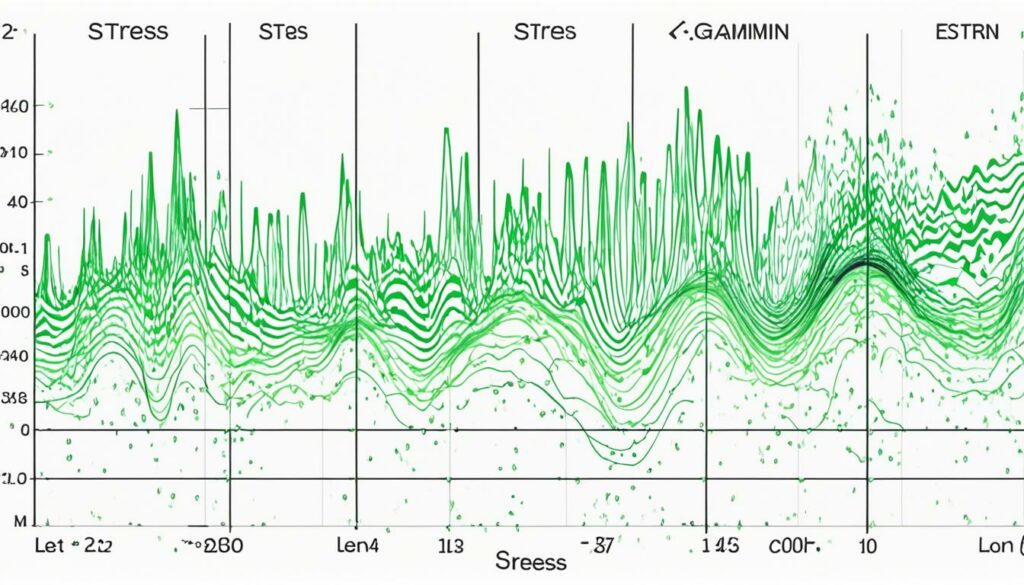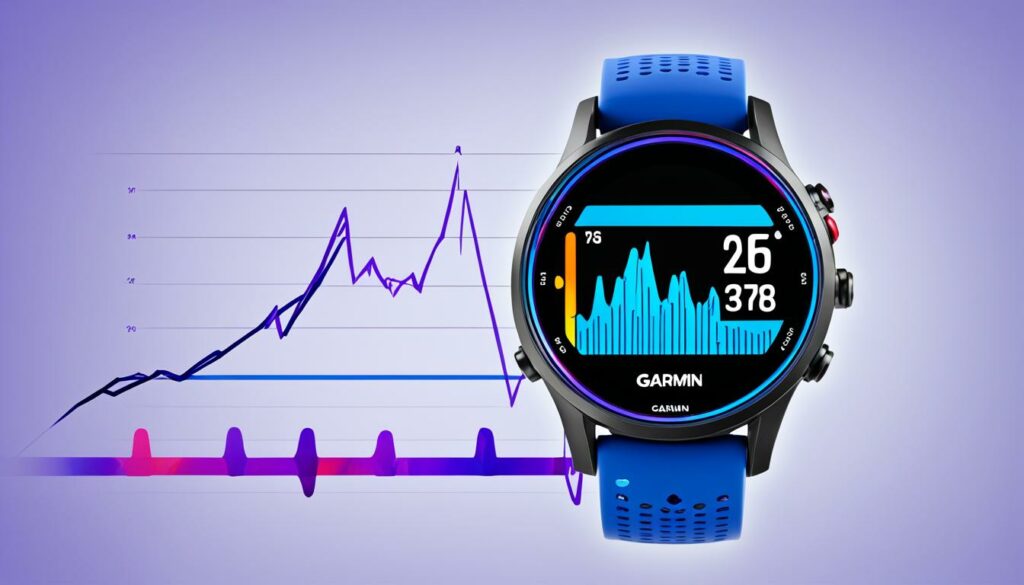Garmin watches have revolutionized the way we monitor and manage our health. With their advanced features and cutting-edge technology, they provide valuable insights into various aspects of our well-being. One such feature is the ability to measure stress levels, offering users a comprehensive understanding of their mental and physical state.
Garmin utilizes a unique stress tracking technology that combines various biometric data to generate a stress score. This score not only helps users monitor their stress levels but also enables them to make informed decisions to manage stress effectively.
Key Takeaways:
- Garmin watches use heart rate variability (HRV) to measure stress levels.
- HRV analyzes small changes in heart rate during rest and activity.
- The stress score is calculated based on HRV data combined with other biometrics from the watch.
- Garmin stress scores range from 1 to 100, with higher scores indicating higher stress levels.
- Understanding Garmin stress levels can help individuals proactively manage their stress.
How Garmin Measures Stress Using HRV
Garmin watches employ a sophisticated technology called heart rate variability (HRV) to measure stress levels effectively. HRV analysis involves studying the variations between successive heartbeats, which provides valuable insights into a person’s stress levels. By analyzing these fluctuations, Garmin can accurately determine individuals’ stress levels and assist them in managing their stress more effectively.
To calculate stress scores, Garmin combines HRV data with other biometric information, such as sleep cycles, activity levels, and nutrition data. This holistic approach ensures a comprehensive understanding of an individual’s stress levels, enabling users to make informed decisions and lifestyle adjustments.
“The measurement of stress through heart rate variability helps individuals gain valuable insights into their overall well-being and empowers them to take proactive steps in stress management.”
Garmin Stress Tracking Process
Garmin’s stress tracking process is a combination of cutting-edge technology and advanced algorithms. By incorporating HRV data along with various biometric inputs, Garmin provides users with a stress score that reflects their stress levels accurately.
The stress score is a comprehensive representation of an individual’s stress at a particular moment. This score takes into account not only the individual’s physiological response but also their sleep patterns, activity levels, and nutrition habits. By considering all these factors, Garmin offers a holistic approach to stress tracking and management.
The Importance of Heart Rate Variability (HRV) in Stress Measurement
Heart rate variability (HRV) is a valuable indicator of an individual’s stress levels. It measures the variation in time intervals between successive heartbeats, reflecting the body’s ability to adapt to stressors.
Higher HRV indicates better adaptability, suggesting lower stress levels, while lower HRV suggests reduced adaptability and higher stress levels. By leveraging this physiological parameter, Garmin accurately measures stress and provides users with a comprehensive understanding of their stress levels.
Interpreting Garmin’s Stress Scores
Garmin’s stress scores range from 0 to 100, with higher scores indicating higher stress levels. It is essential to understand that occasional fluctuations in stress scores are normal and can be influenced by various factors, such as physical activity, sleep quality, or daily events.
To interpret stress scores effectively, it is recommended to examine long-term patterns rather than focusing on individual readings. Identifying trends and triggers can provide insights into the factors that contribute to stress levels, enabling users to develop personalized stress management strategies.
| Factors Influencing Stress Levels | Stress Impact |
|---|---|
| Sleep quality and duration | High impact |
| Physical activity level | Moderate impact |
| Diet and nutrition | Moderate impact |
| Emotional well-being | High impact |
| Work-related stress | High impact |
Accuracy of Garmin’s Stress Levels
The accuracy of Garmin’s stress levels feature has been a topic of debate. While Garmin claims that their technology can provide an accurate assessment of stress levels, it is important to consider several factors.
“The accuracy of the feature depends on how the device is worn, as it needs to be in close contact with the skin to detect heart rate properly.”
The primary factor used to measure stress is heart rate variability (HRV). However, HRV can be influenced by various factors, such as environmental conditions and individual physiological differences, making it challenging to rely solely on HRV data for accurately measuring stress levels.
Additionally, it is important to note that Garmin’s stress level feature should not be seen as a substitute for medical advice. While it can provide valuable insights into an individual’s stress levels, it is always recommended to consult with a medical professional for personalized stress management strategies.
Despite these considerations, Garmin’s stress tracking feature remains a useful tool for individuals seeking to monitor their stress levels and make informed decisions about their well-being.

Factors Affecting Accuracy of Garmin’s Stress Tracking
| Factors | Impact on Accuracy |
|---|---|
| Device Placement | Inaccurate readings if not in close contact with the skin |
| Environmental Conditions | Affects heart rate variability measurements |
| Individual Physiological Differences | Variations in HRV measurements among individuals |
Interpreting Garmin’s Stress Scores
Garmin’s stress scores offer valuable insights into an individual’s stress levels, helping them understand and manage their overall well-being. These scores range from 0 to 100, with lower scores indicating lower stress levels and higher scores indicating higher stress levels. However, it is important to interpret these scores in the context of an individual’s lifestyle and specific triggers.
Fluctuations in stress scores throughout the day or in response to different activities or situations are normal and should not cause panic or overreaction. Instead, users should focus on identifying patterns over time and recognizing specific triggers that may contribute to increased stress levels.
By analyzing Garmin’s stress data, individuals can gain a better understanding of their stress levels and make targeted lifestyle adjustments. This helps them effectively manage stress and promote a healthier well-being overall.
For example, a user may notice that their stress levels tend to be higher in the morning, possibly due to work-related stressors. Armed with this information, they can implement stress management techniques such as meditation or time management strategies to alleviate this morning stress.
Additionally, Garmin’s stress scores can be complemented with other health metrics such as sleep quality, physical activity levels, and nutrition data. This comprehensive approach allows individuals to gain a holistic understanding of their well-being and make informed decisions regarding their lifestyle choices and stress reduction strategies.
The following table showcases a hypothetical example of how Garmin’s stress scores, sleep data, and activity levels can be analyzed and interpreted:
| Date | Stress Score | Sleep Quality | Activity Level | Interpretation |
|---|---|---|---|---|
| 01/01/2022 | 80 | Good | Moderate | The individual had a high-stress score, possibly due to a challenging workday. Despite that, their sleep quality was good, and they engaged in moderate physical activity, indicating effective stress management. |
| 01/02/2022 | 30 | Poor | Low | The individual had a low-stress score, but their sleep quality was poor, and they engaged in minimal physical activity. This suggests that other factors, such as lack of sleep or sedentary behavior, may be contributing to their overall well-being. |
| 01/03/2022 | 60 | Good | High | The individual experienced a moderate-stress score, but their sleep quality was good, and they had a high activity level. This indicates a well-balanced lifestyle with potential room for slight stress reduction strategies. |
By interpreting Garmin’s stress scores in conjunction with other relevant data points, individuals can gain valuable insights into their stress levels and make proactive changes to improve their overall well-being.

Conclusion
Garmin’s stress measurement technology, utilizing heart rate variability analysis, offers valuable insights into an individual’s stress levels and serves as a powerful tool for managing stress. By understanding how Garmin measures stress and interpreting the stress scores, users can gain a deeper understanding of their stress levels and make informed decisions to reduce stress and enhance overall well-being.
Garmin’s stress measurement feature, complemented by other innovative functionalities such as body battery, sleep tracking, and fitness tracking, provides a comprehensive approach to achieving optimal health and wellness. With Garmin, users can track their stress levels alongside other essential wellness metrics, empowering them to make lifestyle adjustments and proactively manage their stress for a better quality of life.
It’s important to remember that while Garmin’s stress scores offer valuable insights, they should be viewed as a tool for monitoring and managing stress levels rather than the sole determinant of an individual’s stress levels. Seeking professional advice from a medical healthcare provider is always recommended for a personalized stress management plan.
With Garmin’s stress measurement technology, managing stress becomes more personalized and effective, providing individuals with the tools and insights needed to lead a healthier, more balanced life.
FAQ
How does Garmin measure stress?
Garmin measures stress levels using a technology called heart rate variability (HRV). HRV analyzes the differences between successive heartbeats to determine stress levels.
What factors does Garmin consider in calculating stress scores?
Garmin combines HRV data with other biometrics, such as sleep cycles, activity level, and nutrition data, to calculate stress scores.
Are Garmin’s stress levels accurate?
The accuracy of Garmin’s stress levels feature depends on factors like how the device is worn and the variability of HRV data. It is important to note that Garmin’s stress level feature should not replace medical advice.
What is the range of Garmin’s stress scores?
Garmin’s stress scores range from 0 to 100, with lower scores indicating lower stress levels and higher scores indicating higher stress levels.
How should I interpret Garmin’s stress scores?
Users should look for patterns over time and specific triggers that may contribute to stress levels. Fluctuations in stress scores are normal, so it is important not to panic or overreact to them.
Can Garmin’s stress measurement technology help in managing stress?
Yes, by understanding how Garmin measures stress and interpreting the stress scores, individuals can make informed decisions and lifestyle adjustments to reduce stress and achieve better well-being.



